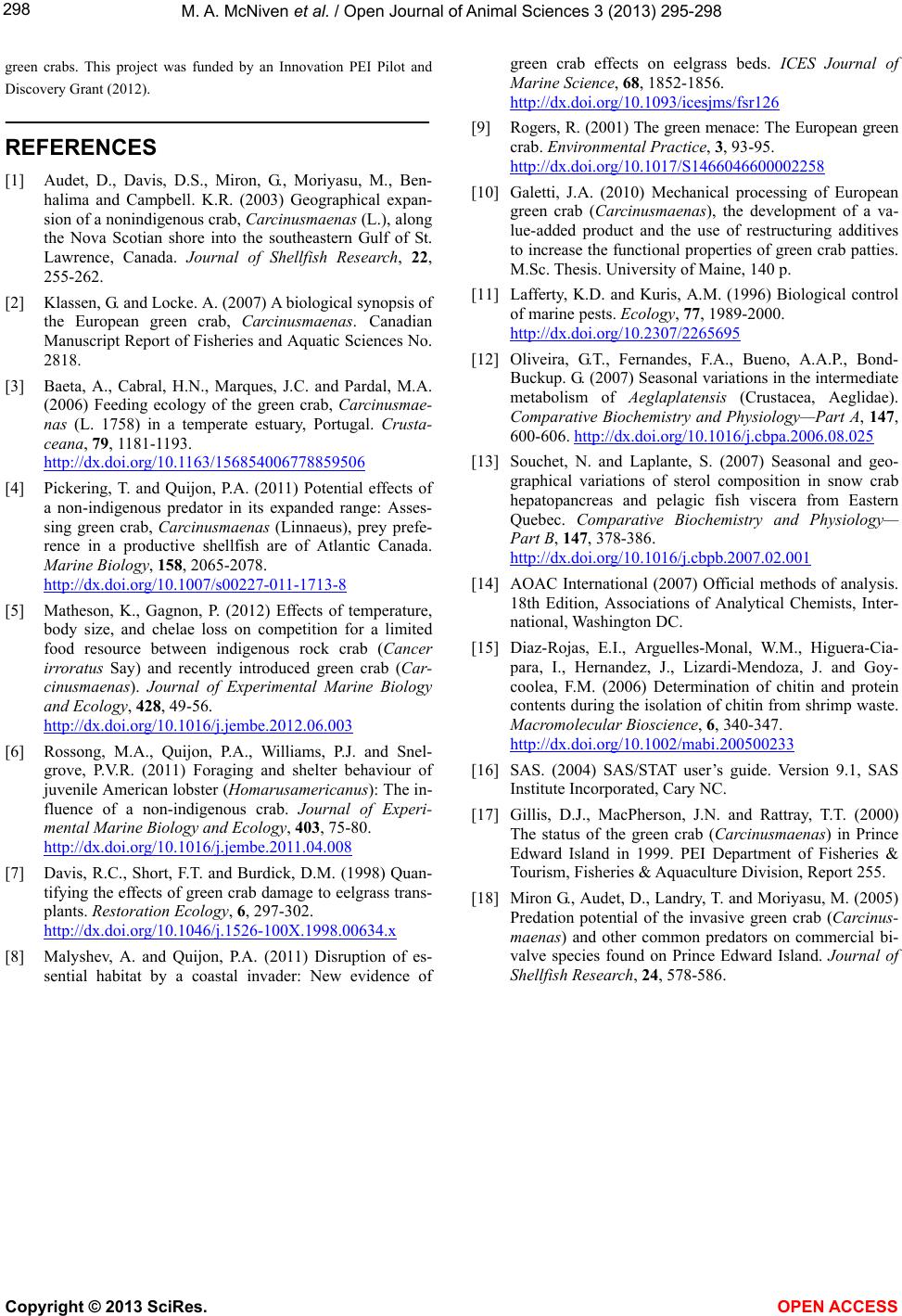
M. A. McNiven et al. / Open Journal of Animal Sciences 3 (2013) 295-298
298
green crabs. This project was funded by an Innovation PEI Pilot and
Discovery Grant (2012).
REFERENCES
[1] Audet, D., Davis, D.S., Miron, G., Moriyasu, M., Ben-
halima and Campbell. K.R. (2003) Geographical expan-
sion of a nonindigenous crab, Carcinusmaenas (L.), along
the Nova Scotian shore into the southeastern Gulf of St.
Lawrence, Canada. Journal of Shellfish Research, 22,
255-262.
[2] Klassen, G. and Locke. A. (2007) A biological synopsis of
the European green crab, Carcinusmaenas. Canadian
Manuscript Report of Fisheries and Aquatic Sciences No.
2818.
[3] Baeta, A., Cabral, H.N., Marques, J.C. and Pardal, M.A.
(2006) Feeding ecology of the green crab, Carcinusmae-
nas (L. 1758) in a temperate estuary, Portugal. Crusta-
ceana, 79, 1181-1193.
http://dx.doi.org/10.1163/156854006778859506
[4] Pickering, T. and Quijon, P.A. (2011) Potential effects of
a non-indigenous predator in its expanded range: Asses-
sing green crab, Carcinusmaenas (Linnaeus), prey prefe-
rence in a productive shellfish are of Atlantic Canada.
Marine Biology, 158, 2065-2078.
http://dx.doi.org/10.1007/s00227-011-1713-8
[5] Matheson, K., Gagnon, P. (2012) Effects of temperature,
body size, and chelae loss on competition for a limited
food resource between indigenous rock crab (Cancer
irroratus Say) and recently introduced green crab (Car-
cinusmaenas). Journal of Experimental Marine Biology
and Ecology, 428, 49-56.
http://dx.doi.org/10.1016/j.jembe.2012.06.003
[6] Rossong, M.A., Quijon, P.A., Williams, P.J. and Snel-
grove, P.V.R. (2011) Foraging and shelter behaviour of
juvenile American lobster (Homarusamericanus): The in-
fluence of a non-indigenous crab. Journal of Experi-
mental Marine Biology and Ecology, 403, 75-80.
http://dx.doi.org/10.1016/j.jembe.2011.04.008
[7] Davis, R.C., Short, F.T. and Burdick, D.M. (1998) Quan-
tifying the effects of green crab damage to eelgrass trans-
plants. Restoration Ecology, 6, 297-302.
http://dx.doi.org/10.1046/j.1526-100X.1998.00634.x
[8] Malyshev, A. and Quijon, P.A. (2011) Disruption of es-
sential habitat by a coastal invader: New evidence of
green crab effects on eelgrass beds. ICES Journal of
Marine Science, 68, 1852-1856.
http://dx.doi.org/10.1093/icesjms/fsr126
[9] Rogers, R. (2001) The green menace: The European green
crab. Environmental Practice, 3, 93-95.
http://dx.doi.org/10.1017/S1466046600002258
[10] Galetti, J.A. (2010) Mechanical processing of European
green crab (Carcinusmaenas), the development of a va-
lue-added product and the use of restructuring additives
to increase the functional properties of green crab patties.
M.Sc. Thesis. University of Maine, 140 p.
[11] Lafferty, K.D. and Kuris, A.M. (1996) Biological control
of marine pests. Ecology, 77, 1989-2000.
http://dx.doi.org/10.2307/2265695
[12] Oliveira, G.T., Fernandes, F.A., Bueno, A.A.P., Bond-
Buckup. G. (2007) Seasonal variations in the intermediate
metabolism of Aeglaplatensis (Crustacea, Aeglidae).
Comparative Biochemistry and Physiology—Part A, 147,
600-606. http://dx.doi.org/10.1016/j.cbpa.2006.08.025
[13] Souchet, N. and Laplante, S. (2007) Seasonal and geo-
graphical variations of sterol composition in snow crab
hepatopancreas and pelagic fish viscera from Eastern
Quebec. Comparative Biochemistry and Physiology—
Part B, 147, 378-386.
http://dx.doi.org/10.1016/j.cbpb.2007.02.001
[14] AOAC International (2007) Official methods of analysis.
18th Edition, Associations of Analytical Chemists, Inter-
national, Washington DC.
[15] Diaz-Rojas, E.I., Arguelles-Monal, W.M., Higuera-Cia-
para, I., Hernandez, J., Lizardi-Mendoza, J. and Goy-
coolea, F.M. (2006) Determination of chitin and protein
contents during the isolation of chitin from shrimp waste.
Macromolecular Bioscience, 6, 340-347.
http://dx.doi.org/10.1002/mabi.200500233
[16] SAS. (2004) SAS/STAT user’s guide. Version 9.1, SAS
Institute Incorporated, Cary NC.
[17] Gillis, D.J., MacPherson, J.N. and Rattray, T.T. (2000)
The status of the green crab (Carcinusmaenas) in Prince
Edward Island in 1999. PEI Department of Fisheries &
Tourism, Fisheries & Aquaculture Division, Report 255.
[18] Miron G., Audet, D., Landry, T. and Moriyasu, M. (2005)
Predation potential of the invasive green crab (Carc inus-
maenas) and other common predators on commercial bi-
valve species found on Prince Edward Island. Journal of
Shellfish Research, 24, 578-586.
Copyright © 2013 SciRes. OPEN ACCESS